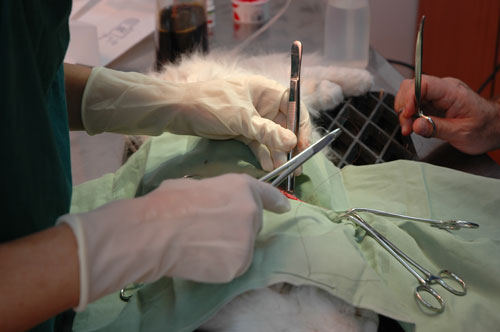
For some procedures, your pet will need to be administered general anesthesia so that he or she will be unconscious and not feel pain. Many pet owners worry about their pets being administered general anesthesia. We can assure you that modern anesthesia is generally quite safe; to further lower any risk, we perform a physical examination and run blood work ahead of time to catch any underlying health issues. In addition, we follow a specific anesthetic protocol, custom built for your pet’s individual needs.
During surgery and other medical procedures, our team of veterinarians and veterinary technicians monitors all patients to ensure their safety. We monitor every procedure, regardless of whether it’s routine or more advanced. The type of anesthesia we use depends on the procedure. Some require general anesthesia, while others may only call for local anesthesia. For more specific information on our protocols, please see the individual descriptions or contact us with any questions. Anesthesia like many parts of veterinary medicine are not the same from clinic to clinic, and practice to practice. We “Make Lives Better” and that is the fundamental decision maker in everything we do. When we choose anesthetic medications, monitoring systems, pain control and pre-anesthetic blood work we choose the smartest, safest and best options for your pet. When your pet has surgery, it receives a physical exam, pre-anesthetic bloodwork, IV catheter and fluids, constant ECG and blood pressure and monitoring, sterile instruments. When you see your pet in the surgery ward it looks like you are having surgery. We choose our premedication and anesthetic drugs based on all the preoperative information that we have available. Each anesthetic plan and protocol is tailored to the patient. We have the ability to use BOTH Isoflurane and Sevoflurane, just like every University Teaching Hospital and surgical referral center does. We want the ability to choose the safest, highest quality, yet cost effective anesthetic plan available for your precious family member. One aspect of anesthetic monitoring that Pine Cone Pet Hospital uses that most practices do not is constant Blood Pressure monitoring. Blood pressure is one of the best ways to monitor the depth of anesthesia and a good indicator of whether to increase or decrease the level of anesthetic gas that your pet is receiving. Most practices do not even have the ability to check blood pressure, and the ones that do will check it manually once or twice during the procedure. At Pine Cone Pet Hospital our anesthetic monitor gives the doctor and veterinary technician a constant readout of blood pressure measured every couple of minutes. This is an example of one of the many small details that we consider important, that other veterinary clinics may not have to keep the cost down. Outwardly you cannot compare apples to apples when comparing prices of veterinary care. Ultimately how do you want your pet treated? We fundamentally make lives better, we just happen to be a great Veterinary Hospital.
Please contact us if you have any questions or concerns about your pet receiving general anesthesia or about the procedure for which your pet is scheduled.
Your OTHER Family Doctors
Our veterinarians at Pine Cone Pet Hospital, serving the pet and animal parents of Sartell, St. Cloud, Sauk Rapids, Waite Park, St. Joseph, Rice and St. Stephen, MN since 2001.
